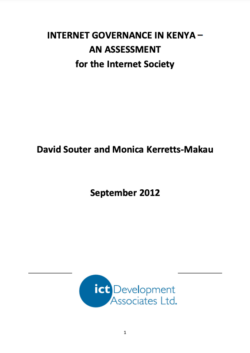Background and objectives
This report describes and assesses the national environment for Internet governance in Kenya in April 2012, with some supplementary material from the meeting of the Kenya Internet Governance Forum which was held in July 2012.
It has been compiled in accordance with a framework for national assessments of Internet governance prepared for the Internet Society in early 2012. As well as standing on its own terms as a study of Internet governance in Kenya, it also acts as a pilot implementation of that framework, which is described in section B below. The Internet Society hopes that this methodology can be used for a number of comparative studies of Internet governance in different countries, in Africa and elsewhere, which could help to develop thinking about future requirements at both national and international levels.
Internet governance is defined, in the framework and in this study, as it was defined by the World Summit on the Information Society in 2005, i.e. as
the development and application by Governments, the private sector and civil society, in their respective roles, of shared principles, norms, rules, decision-making procedures and programmes that shape the evolution and use of the Internet.1
This definition includes both the technical governance of the Internet – its protocols and standards, coordination, domain name management etc. – and the interface between the Internet and other public policy domains which are affected by its use.
Internet governance has been characterised, at both international and national levels, by the participation of diverse stakeholder groups. These include international entities concerned with the Internet itself (such as ICANN, the Internet Engineering Task Force (IETF) and the Internet Governance Forum (IGF)), intergovernmental organisations, national governments, private sector businesses, civil society organisations, and the Internet technical and professional community. Much of the decision-making which affects the evolution and use of the Internet takes place through processes and in fora which lie outside the governmental and intergovernmental arrangements that predominate in other technical and policy domains.
The relationship between global and national governance of the Internet is complex. The Internet is often described as inherently global rather than national in character, with technical characteristics, values and structures that bypass national governance arrangements. In practic e, however, national governance arrangements are also highly significant –in technical areas such as the management of country level domains (ccTLDs); in the deployment of the underlying infrastructure on which the Internet depends, which is subject to national regulation; and at the interface between the Internet and other policy domains which are subject to national laws and social norms. This report, and others that will be based on the Internet Society framework, are concerned with these national dimensions of Internet governance and with the ways in which they interact with international or global governance arrangements.
The assessment of Kenya’s Internet governance environment in this report is therefore built around three main building blocks:
- the issues of Internet governance which are significant today;
- the stakeholders that play a part in national Internet governance; and
- the decision-making processes and fora which affect the evolution and use of the Internet at national
- level.
It seeks to address six research questions which are identified in the ISOC framework for national assessments. These are:
a. What is the general level of understanding and participation in Internet governance in Kenya?
b. What are the principal issues of Internet governance, and how are these changing over time?
c. Who are the principal stakeholders in Internet governance at national level, and how do they interact with one another?
d. What are the decision-making processes and fora that influence the evolution and use of the Internet in Kenya?
e. How do these issues, stakeholders and decision-making processes interact?
f. How effective is this national Internet governance environment perceived to be by stakeholders, what challenges arise from it, and how might they be addressed by national stakeholders and ISOC.
The structure of the report is as follows:
- Chapter 1 outlines the background and methodology for the study.
- Chapter 2 sets out the facts and figures of Internet development and use in Kenya, and outlines national
- policy objectives for the Internet.
- Chapter 3 maps the issues, stakeholders and decision-making fora of significance within the country, as things stand today.
- Chapter 3A is concerned with issues.
- Chapter 3B is concerned with stakeholders.
- Chapter 3C is concerned with decision-making processes and fora.
- Chapter 3D summarises perceptions of Internet governance in Kenya emerging from discussions held as part of the research.
- Chapter 4 summarises the findings and makes recommendations to ISOC and national stakeholders.
One further point should be borne in mind throughout this report. The Internet experiences continual change in its technology and services, in the reach of access networks, the number and experience of Internet users, and the impact which it has on economy and society, politics and culture. Innovations such as cloud computing, Web 2.0 and social networking have had very substantial effects on the Internet and the ways in which it affects society in the few years since the World Summit on the Information Society defined Internet governance in 2005. Internet governance issues and stakeholders, and the decision-making processes and fora which are significant for Internet governance, also change rapidly in response to these developments.
Any study like this is therefore a study of one moment in time. This report describes and assesses Internet governance in Kenya in April 2012, with some supplementary information from the national Internet Governance Forum in July 2012. Its findings and conclusions would have been different in April/July 2010 and would be different again in April/July 2014. While it has value for the future, it should be understood within its chronological as well as geographical context.
Endnotes
1 WSIS, Tunis Agenda for the Information Society, 2005, para. 34, http://www.itu.int/wsis/docs2/tunis/off/6rev1.htm
